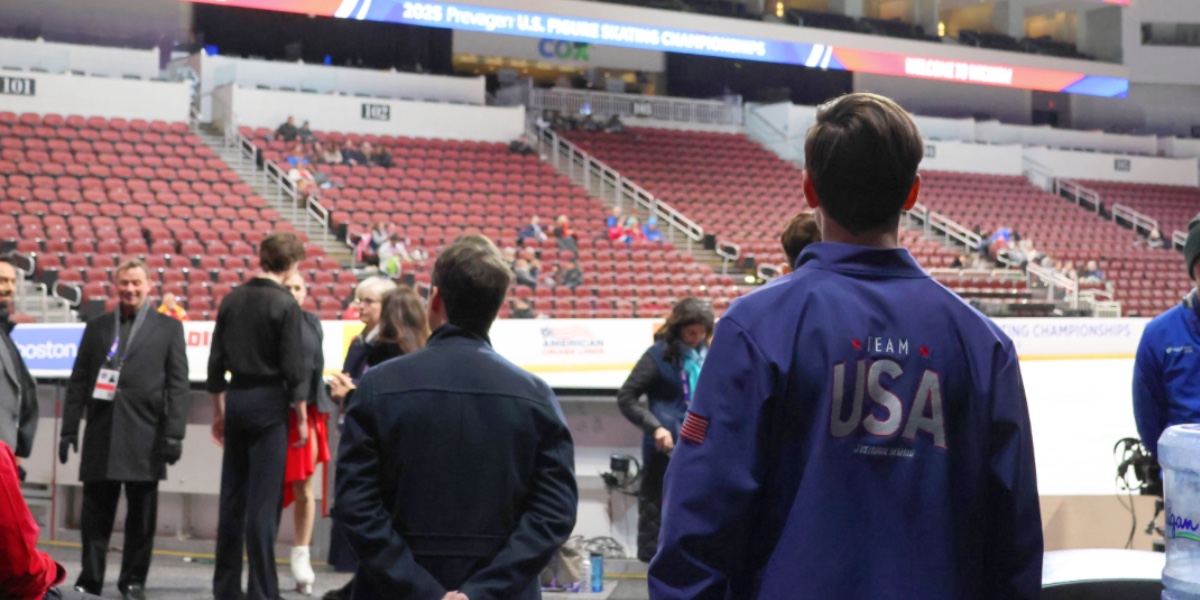Author’s note: This story was produced prior to the tragic news that a flight from Wichita to Washington, D.C., carrying a number of skaters and attendants from the U.S. Figure Skating Championships, crashed on January 29. We stand with the U.S. Figure Skating community, with the families of all the victims, and with all those in Wichita grappling with the heartbreaking loss. The following article highlights the educational experiences of KansasCOM medical students who shadowed as medical support at the national competition.
Behind the dazzling performances of top ice skaters at the 2025 Prevagen U.S. Figure Skating Championships in Wichita was a unique educational opportunity for some medical students from Kansas Health Science University’s Kansas College of Osteopathic Medicine (KansasCOM) as they shadowed physicians volunteering as medical support.
The national championships held at INTRUST Bank Arena in January featured men’s singles, women’s singles, pairs, and ice dance across senior, junior, and novice levels. The spectacle brought millions of dollars to Wichita and was broadcast on NBC and USA Network and streamed on Peacock. Each year the national championships serve as the final qualifier for the U.S. World and World Junior Championship teams, and in Olympic years, they help decide who is nominated for the U.S. Olympic Figure Skating Team.
One of the KansasCOM faculty members who spent time monitoring athletes throughout the week was James Joseph Jr., MD, assistant dean for clinical education and assistant professor of orthopedic surgery.
“This is a world-class event. It is remarkable,” he said. “These are potential multi-million-dollar athletes coming to town, and they’re serious about their trade. It’s important that we afford them reasonable care because this has incredible importance for their futures, even for the juniors working their way up through the system.”
Weeks before the competitions began, organizers asked local physicians to sign up for times during the week to fulfill legal requirements to have medical professionals on-site. When Dr. Joseph learned about the opportunity, he and his long-time colleague Dr. Joaquin Santos, KansasCOM clinical faculty, asked to bring along student doctors interested in sports medicine. The two physicians have worked together as team doctors for more than three decades, and they have offered hands-on educational opportunities for medical students at other major sporting events, including the College World Series.
First-year student doctor Nicole Terpack said that seeing the triage system of care for the figure skaters and their surrounding trainers, nutritionists, and therapists was valuable as she works toward becoming a primary care sports medicine physician.
“The amount of medical staff is really cool,” Terpack said. “They have physical therapists, physical therapy students, and a big team collaborating. It’s not just the physicians. It’s amazing to see everyone working together in one place.”
At the U.S. Figure Skating Championships, athletic trainers serve as first responders whenever there are potential injuries on the ice, referring athletes to physicians for further evaluation when necessary. Following a rare major injury, physicians may ultimately need to decide if an athlete can continue to skate.
Sitting rink side or in the stands for the routines and practice sessions, the doctors and students observed the acute setting where injuries could take place.
The physicians recounted treating a junior athlete after observing him take a fall beneath his skating partner. Dr. Santos saw him for his dizziness and Dr. Joseph for his hurt elbow and shoulder.
Dr. Santos said, “He had his female partner above his head, and they got tangled up and went to the ground and he was underneath her. His arm and the elbow were in an awkward position. He suffered a small laceration, but in addition to that, he came out after the practice feeling a bit dizzy. So, we evaluated him very cursorily for early concussion.”
Though the skater denied he hit his head on the ice, Dr. Santos followed up with him the next day, and his dizziness had resolved.
Dr. Joseph emphasized that seeing the mechanism of injury can substantially aid in diagnosis.
“That’s why I sit out here and watch,” he said, recalling the case of the junior skater. “I knew exactly what to look for. So, it’s important for our students to know that they need to be out in the world and paying attention to what they’re doing and observing because that’s a real key to diagnostics and therapy.”
Students also learned about the unpredictable pacing of event medicine. On some shifts, like the practice session for the couple’s competitions, they spent a lot of time observing and waiting, a significant difference from clinical settings with set schedules or those with fast-paced environments.
Dr. Santos said, “The streets of Wichita have been icy for the past 10 days and so many people have fallen and bumped their heads or broken their hips out walking on their sidewalks. I’ve talked to the emergency room physicians at our school, and on the first day after that first ice storm, they were seeing five or six fractures every hour.”
The relatively slow pace of some of the events afforded students time to chat with the on-site athletic trainers and the skaters. The student doctors also had candid conversations with Dr. Joseph and Dr. Santos about the challenges and rewards of a career in health care.
First-year student doctor Kaitlyn Quigley, said she sees herself applying the physical diagnostic techniques she witnessed in the arena as a future physician, maybe in pediatrics.
“We observed Dr. Santos use casual gestures [with the patient] to get information,” Quigley said. “He explained putting a hand on someone’s back while they’re talking to see how their lungs are working. Some nice, subtle tricks that are incredible to learn about.”
By participating in the nationally recognized championships, these future doctors gained more than just a line on their resumes. They left with a deeper understanding of the dedication, precision, and teamwork required to care for elite athletes.

